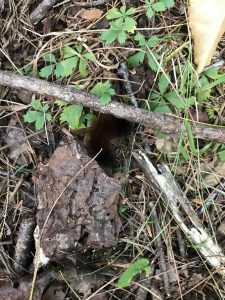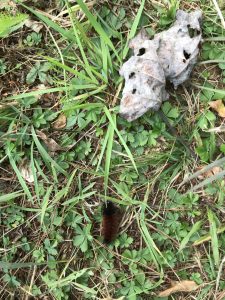I went out to my sit-spot October 3, 2020 and arrived there at 2:40. The organism I picked is what most people know as a woolly worm or woolly bear. It was located next to the tree whose root is still currently exposed and has the moss I’ve been watching grow on it. I identified later on that the woolly worm is actually a caterpillar of the tiger moth whose scientific name is Isia Isabella. I picked this organism because I’ve seen it around here for years, but knew next to nothing about it besides the lore that I grew up with. All I knew was it was called a wooly worm and if there are a bunch of all black ones around then that winter was going to be rough. I observed that it was very fuzzy with black tips and a brown middle region. It didn’t seem to want to move at all. That is until I gave it a light tap with a stick. When I did that it curled into a ball immediately, but after a few seconds of me backing off it returned to its c-like curl state. It didn’t really move until the wind picked up and it got into a tight ball to keep warm or to prepare for being blown away. Luckily the wind wasn’t hard enough to blow it away it was just hard enough to make me put a jacket on over my flannel.
The history I found on it was its lifecycle and information about the winter lore I had heard. Its lifecycle begins after it hatches from its egg. It begins to eat the leaves around it until it is large enough to move on to better sources of food. Once the fall weather begins to drop into frigid winter air the larva begins to enter a frozen hibernate state. The caterpillar will not die in this freeze because its body produces a cryoprotectant that will act as an antifreeze for its organs and tissue. When winter passes and spring arrives, the woolly worm will thaw and begin to once again eat the local plants. Once it is big enough and matured it will begin to create a cocoon around itself from which it will emerge as an adult Tiger Moth. As an adult it has a short time to find a mate and reproduce before it dies and ends its lifecycle. The winter lore is most promenade in the North Carolina mountains. Here it is believed that the worms can predict the winter. For example, if it has thirteen bands of black and brown then there will be thirteen weeks of winter, and the darker the bands the harsher the winter will be. Others say that its simply the more brown it has the more mild the winter and the more black it has the harsher the winter. In North Carolina there is also a festival held in honor of the woolly worm. In Bannar Elk (NC county) the festival has races in which the worms race on three feet of sting in heats until a winner is produced. Once this winner it found it is used to predicted the up coming winter.
Identifying my organism was probably easier than others because I already knew one of its common names. I just googled the common name and found its actual identity. The overall experience was good other than the cold. It’s cool that I know more about them now, but I low-key miss the mystery of this worm appearing out of seemingly nowhere before winter hits, and just wondering how accurate they will be for the up coming winter.


I found this guy on my way back. It was booking it through the grass in an inch worm like movement.

The wolly worm was so cool to learn about! I have always heard about the prediction of winter with these little fellas too, but didn’t know much about the specifics and that there was lore about them. I love the idea of the little festival and races with them! Do you happen to know whether the predictions from the winner are accurate or not? I would love to see if there is a list of the winners, their predictions, and the actual winter! I’m sure if they go through all the trouble of the festival, I would think that they would keep track lol. I never knew that they hibernate and have the cryoprotectant to keep them alive. I just assumed that they died. Awesome info! Thanks!
Wow! I was the same way as you- I knew nothing except what they were called! I was really interested to learn about the folklore of these little guys, I had never heard of that! Perhaps that is something I will look further into sometime when I’m free. I also think it would be super fun to go to that festival (maybe one day when we’re not 6 feet apart)! This was awesome info and I enjoyed learning about the wooly work from your post 🙂
I did not know that this species was even around, so I am so happy that you did a species summary on this. I learned alot from reading your post, so thank you for teaching me something new. The one thing that I would says is that I would cite the references you used for the natural history summary, but other than that I think that your did an excellent job, not only in your descriptions, but also in your natural history summary.